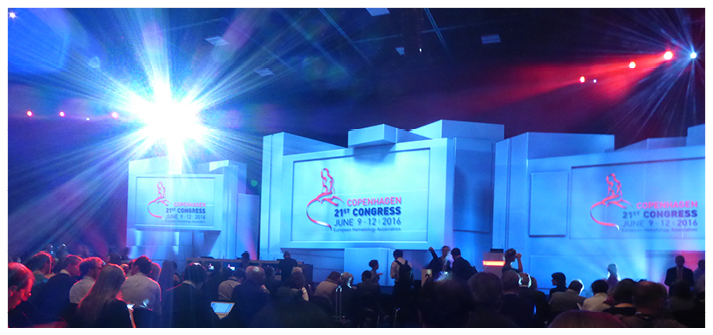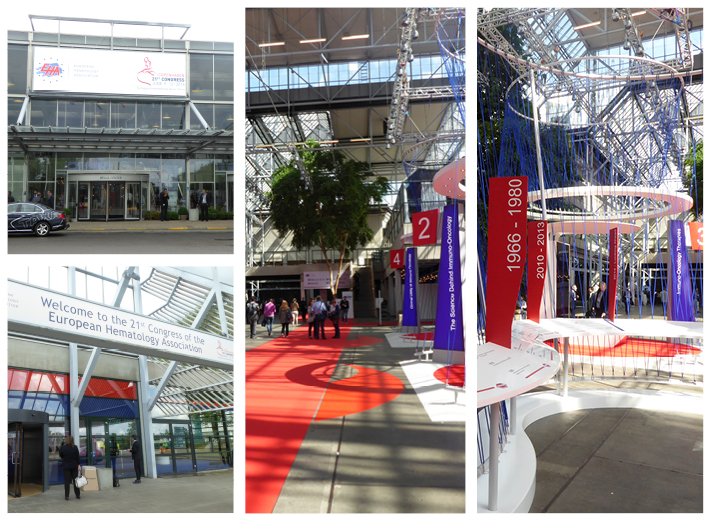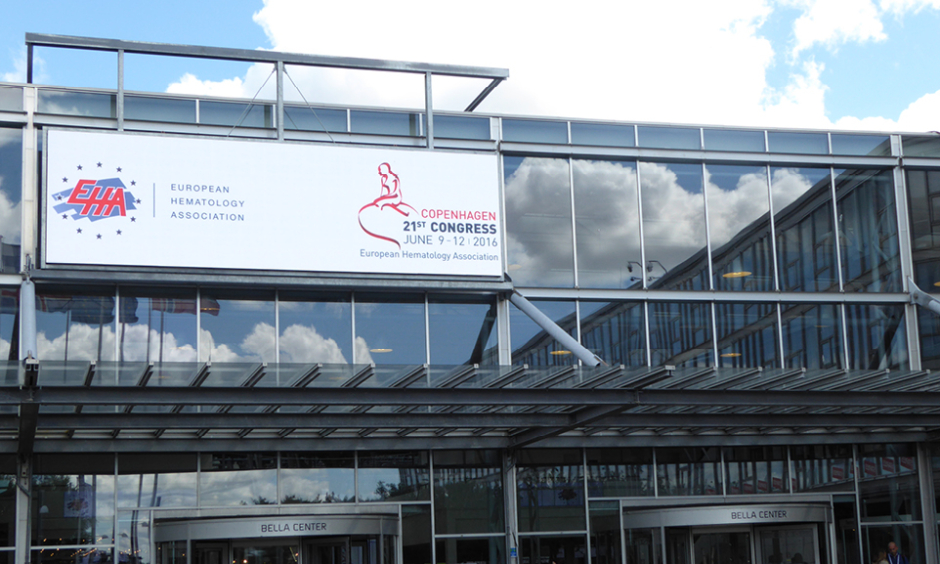The city of Copenhagen has been voted the go-to place for holiday makers in Denmark, and from the 9th of June and the 4 days that followed, it was without a doubt the go-to place for haematologists around the world as the 21st Congress of the European Hematology Association (EHA) 2016 took place there. The beautiful city of Copenhagen is a cultural hub with international appeal, providing the perfect environment to meet and discuss all things haematology.
The EHA congress last appeared in Copenhagen back in 2008, welcoming around 6,500 people in attendance. After its 8-year break from the city, EHA 2016 is now able to boast well over 10,000 attendees. In light of the event’s popularity, the President of the EHA, Prof Tony Green, Haematology Department, University of Cambridge, Cambridge, UK, took the opportunity to express in the opening ceremony address: “We feel confident there is something for everyone.” This year’s congress included a record number of 2,435 submitted abstracts and 84 submitted late breaking abstracts, all highlighting the latest innovations from a vibrant community of basic, translational, and clinical researchers within the field of haematology.
Each year, the EHA recognises important contributions made by leading haematology researchers with the José Carreras Award. This year the award was bestowed upon Prof Eva Hellström Lindberg, Sweden, in recognition of her contributions to translational and clinical research into the pathogenesis and treatment of myelodysplastic syndromes. Established in 2008, the Jean Bernard Lifetime Achievement Award honours the lifetime contributions of outstanding physicians and scientists to the advancement of haematology medicine. This year’s award went to Prof Clara Camaschella, Italy, for her outstanding portfolio of work concerning the pathophysiology of inherited disorders of iron metabolism including hereditary haemochromatosis, genetic iron deficiency, and iron-loading anaemias.
Several EHA research fellowships were allocated to support researchers just beginning their careers and the winners were as follows: The John Goldman Clinical Research Fellowship: H. Poeck (Germany); the Clinical Research Fellowship: G. Jansen (Netherlands); the Non-Clinical Junior Research Fellowship: D. Passaro (UK); the José Carreras Non-Clinical Research Fellowship: A. Nai (Italy); the Non-Clinical Advanced Research Fellowship: E. Laurenti (UK); and M. Crisan (UK). EHA President Prof Green emphasised the commitment of the organisation to the development of junior and early career researchers with the announcement of the launch of the new Clinical Research Training in Hematology programme. “This is a programme that will run throughout the coming year and is specifically targeted at young haematologists with the aim of providing them with a way of becoming specialised in the area of clinical trials,” Prof Green said during the opening ceremony address.
EHA 2016 was an excellent event that brought everyone up to speed with the latest innovations and developments through its comprehensive scientific and educational programme. It brought to the forefront many of the pressing issues and promising results that have emerged from recent haematology research and practice. This includes topics such as whether leukaemia patients can ever move on from life-long tyrosine kinase inhibitor therapy, and the promising results of the high remission rates for leukaemia patients receiving the antibody drug conjugate vadastuximab talirine in a Phase I trial. These are just two amongst the many stories reported in this year’s journal which reflect a brilliant year for the advancement of haematological medicine, and we are already looking forward to next year’s congress, which is set to take place in the Spanish capital, Madrid.

GSGN-CD33A Antibody Drug Causing High Remissions Rates for Leukaemia Patients
SGN-CD33A (also known as vadastuximab talirine) combined with hypomethylating therapy has shown promising results for the treatment of acute myeloid leukaemia (AML) in older patients.
This is according to a EHA press release dated 11th June 2016. It reports on data from an ongoing Phase I trial evaluating the antibody drug conjugate vadastuximab talirine in concert with standard therapies (azacitidine, decitabine) in older AML patients who have declined intensive frontline therapy.
AML is an aggressive form of blood cancer which is difficult to treat in older patients because intensive chemotherapy can cause adverse effects and response rates from standard therapies are modest. SGN-CD33A is targeted to CD33, which is expressed on leukaemic blasts in nearly all AML patients, with expression remaining relatively consistent across the range of ages, risk factors, and disease characteristics. The SGN-CD33A drug conjugate is comprised of a novel antibody system stably linked to a highly potent cell-killing agent.
As of 11th June 2016, 53 AML patients with an average age of 75 years old have been treated with SGN-CD33A combined with either the azacitidine or the decitabine methylating agent. Efficacy evaluation was available in 49 of the patients who had received this treatment. A composite complete remission rate of 73% was measured in the group. The mortality rates were 2% at 30 days and 8% at 60 days. Grade III, or severe adverse events, occurred in at least 20% of the patients who experienced febrile neutropenia, thrombocytopenia, anaemia, and neutropenia. The combination of treatment was found to be well-tolerated by patients and yielded encouraging response rates in older AML patients, which are favourable to other hypomethylating agents in this population.
Results of Ongoing Gene Therapy Study for Haemophilia B Reported
RESULTS of an ongoing study have been reported evaluating the safety and tolerability of a single intravenous infusion designed to facilitate production of the Factor IX (FIX) protein, according to a EHA press release dated 11th June 2016.
Haemophilia B is a genetic bleeding disorder caused by insufficient or defective blood clotting protein FIX, which affects roughly 80,000 males worldwide. Normal clotting factor activity levels range from >40–150%. Individuals with haemophilia B have FIX activity levels of <1%. This can result in recurrent joint, muscle, and tissue bleeding, as well as life-threatening bleeding in closed spaces such as the brain.
Prophylactic FIX protein replacement has been found to be effective in patients who fully adhere to the treatment. In spite of this, the burden of once or twice weekly intravenous infusions has meant that the treatment is not yet approved for widespread use. Researchers have provided updates on an ongoing Phase I/II study which is evaluating safety and tolerability of a single intravenous infusion of the gene transfer product SPK-9001. This product has been designed to allow the body to produce its own FIX protein by transferring a functioning FIX gene into the body of the patient.
As of 11th June 2016 four participants have been followed for 7–26 weeks after a single intravenous infusion with 5×1011 vector genomes/kg of SPK-9001 without the need for immunosuppression. No serious adverse effects related to the product or procedure have been reported, including immune responses, and no patients have required steroids or other medications to suppress the immune system.
As of 22nd May 2016 patients showed FIX activity levels of 32%, 39%, 25%, and 27%, respectively. These levels are above the threshold of 12% required to reduce the risk of bleeding. The participants are no longer infusing FIX protein products and all are free from bleeding with the exception of a suspected ankle bleed in one patient 2 days after the gene transfer.

New Oral Anticoagulants Studied as Treatment for Major Bleeding
NEW oral anticoagulants (NOACs) used to treat major bleeding (MB) have been the focus of an international prospective cohort study presented at this year’s EHA Congress in Copenhagen, Denmark, according to a EHA press release dated 10th June 2016.
Death at 30 days was found to be significantly lower in patients treated with NOACs when compared with vitamin K antagonist (VKA) treatment. NOACs are presently used in clinical practice for prophylaxis of venous thromboembolism, along with prevention of stroke and systemic embolism in nonvalvular atrial fibrillation. They are associated with a favourable safety profile in Phase III randomised control trials, having lower incidences of MB compared with VKAs.
The multicentre study was performed to gauge the efficacy of NOACS against VKAs in real-life, comparing clinical presentation, management, and outcome of bleeding. The research incorporated an Italian cohort of nine hospitals and a German cohort from the Dresden NOAC registry, with a primary study outcome of in-hospital death at 30 days. Of the 874 patients hospitalised for MB, 76% of participants were treated with VKAs and 24% treated with NOACs. Incidents of MB included intracranial haemorrhage in 52% and 22% of patients on VKAs or NOACs, respectively; and gastrointestinal bleeding in 25% and 46%, respectively. Thirty-day mortality occurred in 136 patients: 17% of VKAs patients and 10% of NOAC patients.
Leader of the study Dr Laura Franco, Stroke Unit, Vascular and Emergency Medicine, University of Perugia, Perugia, Italy, explained that while NOAC patients have a higher rate of gastrointestinal bleeding and lower rate of intracranial haemorrhage than VKA patients, these rates differ across bleeding sites. She commented: “The great advantage of NOACs is the reduced risk of intracranial haemorrhage, so we show that the lower mortality rate is due, not to an intrinsic capacity to reduce death between NOAC as compared with VKA patients, but to a different pattern of bleeding sites.”
New Form of Invisible Inherited Thrombocytopenia Discovered
MUTATIONS in the ETV6 gene can cause the development of a newly discovered form of inherited thrombocytopenia (IT), a EHA press release dated 10th June 2016 reported. The disorder, named ETV6-related thrombocytopenia (ETV6-RT), is characterised by a deficiency of platelets and puts patients at risk of a number of conditions.
The results of a study presented at this year’s EHA congress in Copenhagen, Denmark, which identified this particular form of IT, suggest that ETV6-RT could present in roughly 5% of patients who have been diagnosed with IT. The disorder is passed on to children if one parent possesses the faulty gene, and is particularly dangerous as its characteristics differ greatly from the recognised warning signs of IT. Firstly, it is one of a very small number of IT variants which do not cause large platelet sizes; and secondly, there is a greatly reduced occurrence of bleeding (often a mild tendency but sometimes none at all).
The risk of blood cancer is a particular concern for paediatric patients with ETV6-RT. The authors of the study noted that, together with the difficulty of diagnosis due to the aforementioned characteristics, the increased risks of developing haematological malignancies, and particularly the risk of childhood B cell acute lymphoblastic leukaemia, should not be underestimated. The authors recommend devoting more attention to detecting blood cancer than the potential bleeding complications associated with the disorder, due to the infrequency of such events, which rarely affect quality of life for patients. Their recommendation is to run genetic screening for the ETV6 mutation in any patient who displays platelets of a normal size but who has been diagnosed with IT.

Pre-leukaemic Stem Cells may be Key to Relapse in Acute Myeloid Leukaemia
PERSISTENCE of pre-leukaemic cells after chemotherapy is associated with recurrence of acute myeloid leukaemia (AML), according to a EHA press release dated 10th June 2016. AML is an aggressive cancer; intensive chemotherapy can induce remission, however recurrence is common especially amongst older patients.
The origin of AML in some patients is a mutation in a pre-leukaemic stem cell clone, this is a stem cell with somatic mutations which can develop into cells with additional mutations or into completely normal cells. Cells with additional mutations can progress to overt AML. Although chemotherapy can induce remission from leukaemia cells, pre-leukaemic cells can remain. This research aimed to divulge whether the persistence of these pre-leukaemic stem cells after chemotherapy changes outcomes and, ultimately, whether it affects survival.
The cohort for this trial consisted of 107 patients who had entered remission during a German multicentre trial. Within these patients, 68 genes with their associated mutations were analysed at diagnosis and following treatment to see if they were cleared by chemotherapy. Remission specimens showed that, in 36% of patients, gene mutations found in leukaemia were still present, indicating the persistence of a pre-leukaemic clone. The genes found included a specific subset including: DNMT3A, TET2, ASXL1, and SRSF2. The presence of these mutations was more common in older patients.
The most important finding from this research is the fact that these persisting mutations resulted in an increased risk of disease recurrence after chemotherapy, compared with those without persisting mutations. This is a step toward understanding why so many patients relapse and how we may soon be treating them beyond the initial chemotherapy.
Dr Klaus Metzeler, University Hospital, Ludwig-Maximilians-University, München, Germany, said: “One thing that we plan to follow-up on this study, is to look at relapses in these patients and to track how often these really come from the pre-leukaemic clone. That would give us further arguments to actually treat patients who have a pre-leukaemic clone after their standard induction chemotherapy.”
Potential Alternative for Relapsed and Refractory Myeloma Patients
MYELOMA patients who have relapsed or become refractory to treatment could have access to an effective alternative following the success of the daratumumab antibody in a Phase III study.
The results of an ongoing, open-label, randomised Phase III study conducted in 18 countries and involving 569 patients have been reported in a EHA press release dated 10th June 2016. The study evaluated daratumumab, a monoclonal antibody that binds to a novel target on myeloma cells, in combination with lenalidomide and dexamethasone. This therapy was compared to a control group who received only the lenalidomide and dexamethasone. All patients involved in the study had relapsed or refractory multiple myeloma and had received at least one prior line of therapy.
Following an interim analysis, researchers found an unparalleled 63% reduction in the risk of progression or death in the group receiving daratumumab when compared to the control group. This led to an early unblinding of the study. Overall responses (p<0.0001) were experienced by 93% of the daratumumab group and 76% by the control group. The extent of treatment response was found to be much higher in those taking daratumumab with 76% patients experiencing a very good partial response or better (p<0.0001) in comparison to 44% of control patients. With regards to a complete response, more than double the number of daratumumab patients (43% versus 19%) experienced a complete response or better (p<0.0001).
The research suggests that this combination could be an effective alternative for refractory and relapsed patients as treatment was considered to be well-tolerated by the daratumumab group with the occurrence of adverse events among patients consistent with the known profiles of these drugs. Furthermore, the study has established a positive benefit/risk profile for daratumumab with lenalidomide and dexamethasone in multiple myeloma patients who have received at least one prior line of therapy.

Immunotherapy Offers Life-Saving Approach to Leukaemia Patients
RELAPSED or refractory (r/r) patients with acute lymphoblastic leukaemia (ALL) may soon have access to a life-saving alternative treatment in the form of an immunotherapy agent. The rate of adults with ALL who achieve disease control with intense chemotherapy is as high as 90%, although only half of those responsive to the treatment will be cured. For those who are unresponsive and r/r after chemotherapy, the resulting outcome is poor, regardless of further chemotherapy or treatment such as allogenic haematopoietic stem cell transplantation. Immunotherapy, however, offers a new treatment alternative for r/r patients by delivering antibody constructs that engage with a patient’s T cells to fight ALL.
According to a EHA press release dated 10th June 2016, the results of previous Phase II trials have shown that blinatumomab, a bispecific T cell engager antibody construct, caused 43% of r/r patients with ALL to achieve disease control. It also reported on a more recent Phase III clinical trial which tested whether blinatumomab could achieve an increased survival benefit in r/r ALL patients compared to standard chemotherapy. The study involved 405 r/r ALL patients from Europe, North America, Asia, and Australia who were randomised in a 2:1 ratio to receive either blinatumomab (n=271) or a standard chemotherapy regimen (n=134). The results showed an improved overall survival of patients receiving blinatumomab.
The Phase II trial was stopped prematurely as the antibody treatment almost doubled the overall survival rate when compared to chemotherapy. This was witnessed in each subgroup of patients, including those who had relapsed after an allogenic haematopoietic stem cell transplantation, multiple different chemotherapy regiments, or both combined. No more severe side effects were seen after treatment with blinatumomab than chemotherapy. The results of the trial indicate that blinatumomab is the first immunotherapy agent proven to extend the life of a patient with r/r ALL when compared with chemotherapy.
Researchers Explore Effects of Leukaemia Patients Ending Life-Long Treatment
THE PROPORTION of chronic myeloid leukaemia patients maintaining a therapeutic response after stopping tyrosine kinase inhibitor (TKI) therapy has been examined in a study spanning across Europe. The study was conducted as an attempt to determine clinical and biological factors that would enable the successful ending of TKI therapy.
TKIs have significantly improved the survival rates of patients in the early chronic stages of chronic myeloid leukaemia yet this form of treatment continues for a period that spans across the lifetime of the patient. Previous research has explored the potential for patients to stop TKI therapy, revealing that 40–60% have been able to do so with a good therapy response.
According to a EHA press release dated 10th June 2016, 868 patients in 11 European countries were registered in the Phase III European Stop Tyrosine Kinase Inhibitor (EURO-SKI) study. The requirements of the study meant patients had to have at least 3 years of TKI therapy and to have had a very good response to therapy for at least 1 year prior to study entry. Patients were also required to have not failed previous TKI treatment in order to be included.
The results of the study showed that 62% of the patients continued to maintain a therapeutic response 6 months after stopping the therapy. After 12 months of the therapy ending, 56% of patients continued a positive therapeutic response. The researchers also found that duration of TKI therapy as well as an encouraging treatment response prior to the end of the therapy was a predictor of whether stopping would be successful. The likelihood of a patient successfully stopping TKI therapy in relation to a patient’s gender, age, or risk score was not determined by the study.

Nivolumab Benefits Patients with Relapsed Hodgkin’s Lymphoma
A STUDY has been undertaken to examine the efficacy and safety of the drug nivolumab for patients with classical Hodgkin’s lymphoma (cHL), according to a EHA press release dated 10th June 2016. The disease typically affects young men and women in their 30s and it is one of the most treatable types of cancer using a combination of chemotherapy and radiotherapy.
Despite this, cHL should still be a high priority, as approximately 20% of patients experience some form of relapse and will not be cured with first or second-line treatments. It hastaken over three decades for a second drug to be introduced, nivolumab, as an effective treatment for the relapse of Hodgkin’s lymphoma. A few years ago, brentuximab vedotin was the first drug to be approved by the US Food and Drug Administration (FDA) for the treatment of Hodgkin’s lymphoma and nivolumab is due to be the second.
Checkmate 205, the registrational trial for the Phase II evaluation of nivolumab with cHL showed positive results. Patients with cHL, after failure of both autologous stem cell transplantation and brentuximab vedotin treatment, were treated with nivolumab. The primary endpoint of objective response rate (ORR) per an independent radiologic review committee was 66.3% and 73% by investigator response (secondary endpoint). The median response time was 2.1 months, and time of remission was 7.8 months, (95% confidence interval: 6.6 to not evaluable). At the time of analysis, 62.3% of responses were ongoing. Forty-three patients who had exhibited no response when receiving brentuximab vedotin had an impressive 72% ORR with the newer drug. The results of the study also found no significant risks of using nivolumab, as the safety profile was consistent with previously reported data of this tumour type.
Ibrutinib Performs Well in Aggressive Leukaemia Trials
POSITIVE outcomes have been observed from an integrated analysis of chronic lymphocytic leukaemia (CLL) patients treated with ibrutinib, reports a EHA press release dated 10th June 2016. CLL patients with deletion of chromosome 17p (del17p) often present with an aggressive disease and characteristically poor outcomes; survival rarely exceeds 2–3 years in patients initially treated with chemotherapy.
The European Union (EU) and USA have nuanced regulations for use of the first-in-class Bruton’s tyrosine kinase inhibitor, ibrutinib, although both have approved its use for those with del17p CLL. Aiming to examine the safety and efficacy outcomes of ibrutinib in this patient population, a cross-study of three clinical trials analysed 243 individuals with del17p CLL treated with once daily ibrutinib 420 mg (n=232) or 840 mg (n=11) to the primary endpoints of progressive disease or ‘unacceptable toxicity’. The median time in study was 28 months at which point overall response rate was consistent across all three trials at 84%.
At a 30-month follow-up, ~55% of the participants were progression-free and 67% had survived, figures exceeding the treatment outcomes of trials investigating alternative del17p CLL therapeutic strategies. Furthermore, adverse events Grade 3 or more leading to treatment discontinuation occurred in 15% of patients (n=36). This study is ongoing, with 45% of the cohort continuing on study treatment, however it is clear from the integrated results of these clinical trials presented at EHA 2016 that ibrutinib is a potential treatment candidate for difficult-to-treat CLL populations. With promising survival outcomes and a relatively low rate of discontinuation from adverse events the continued study of this patient group will have great significance, and further clinical trials of the safety and efficacy of ibrutinib are vital.
Genome Sequencing Used by Scientists to Tackle Blood Disease
RESEARCHERS around the world are currently in the process of sequencing the whole genomes of thousands of patients to identify the genetic causes of blood disorders as well as to gain insights into already known causes of some blood disorders.
Approximately three million people have a rare bleeding disorder or a disease of the platelets. Despite significant progress made in identifying the causes of many such diseases and disorders, many still remain unknown to scientists. The opportunity to generate large amounts of information to aid in future discoveries of the genetic causes of blood disorders and diseases could be a great benefit to millions of patients who experience these common life-threatening events.
According to a EHA press release dated the 11th June 2016, researchers and collaborators across the world supported by the National Institute Health Research (NIHR) BioResource for Rare Diseases in the UK are sequencing the whole genomes of thousands of patients without a genetic diagnosis. By collating the information collected from the sequencing into a research database and running computational analysis, common genetic changes can be identified, which may contribute to the disease.
Already the innovative approach has proved a success. The team have reported on the discovery of a genetic link between large platelets and deafness; a genetic change in a well-known cancer gene responsible for fragile bones; a link between scarring of bone marrow and a low platelet count; and an association between large platelets and heart rhythm problems. The team also explained that these discoveries and others have been able to benefit patients through accessible genetic testing available in the UK and elsewhere provided by thrombogenomics.org.uk.







